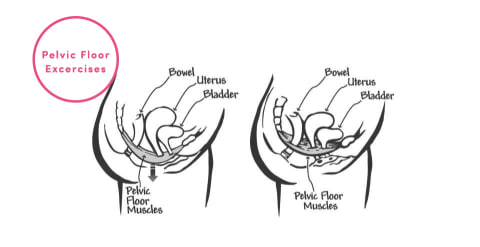Advertisement
How To Do Kegel Exercises Correctly + Benefits, According To An OB/GYN


Having strong pelvic floor muscles can improve sexual health and overall health of the vagina. With age, sex hormones start to naturally decrease, which leads to weakening of the muscles and dryness of the vagina.
While those changes are inevitable, they don't have to affect our quality of life (or the quality of our sex lives.) One way to support our sexual wellness is by engaging in Kegel exercises regularly—and more importantly, by making sure we're doing them correctly.
Finding your pelvic floor muscles.
In order to do your pelvic floor exercises correctly, it's important to know exactly where the muscles are. In order to identify them, try stopping you urination mid-stream. To do this, imagine you're bringing everything in your pelvic region up and together. That clenching sensation should activate the right set of muscles.
If you're still unsure, speak to your gynecologist or a pelvic floor physical therapist, and keep this graphic in mind:

Step-by-step guide to Kegel exercises.
- Visualize your perineal body1 (use the image above for context.) This is generally the region between the vagina and anus and often described as the "anchor of the pelvis."
- Pull up on the perineal body, exhale, and really feel those pelvic floor muscles come up and contract together.
- Hold that contraction for a count of three, then relax. (With practice, you may work your way up to a count of six or eight).
- Repeat three sets of eight lifts. Do this three to five times per week.
Keep in mind: While holding your pelvic muscles up, continue to breathe normally and stay relaxed so you don't create counterproductive abdominal pressure. Here: a video visualization.
How to check for results.
Remember the pee test from above? Not only can that help you identify your kegel muscles, but it's also a good way to test your progress. When you start to urinate, stop the pee mid-flow. This time, try to hold it for eight seconds without leaking. That's hard to do, but it's a good way to test whether your pelvic floor exercises are being done correctly.
Only do this test once or twice a week—not every time you use the bathroom. Doing it too often may negatively train your bladder to not empty completely.
If you're worried about messing with your bladder, another good test is to put your fingers on the perineal body. As you contract the pelvic floor, you should feel it rise. Do this lying down on your side so you're not putting abdominal pressure on the pelvic floor—this will allow you to relax and focus on the muscle.
Benefits of Kegel exercises
Kegel exercises help to strengthen the pelvic floor muscles, which support organs including the uterus, bladder, sigmoid colon, rectum, and vagina. These muscles can become weakened through childbirth, pregnancy, chronic constipation, menopause, and more.
By exercising these muscles, it supports the pelvis and its surrounding organs, which helps to Improve urine storage, stool elimination, and sexual function. It may also decrease pain from sex and could help with childbirth.
Bottom Line
Our pelvic floor is important for our overall health, so don't sit on it all day. Have fun with these exercises and make them a part of your daily routine to strengthen your pelvic floor muscles. Looking to relax yours? Try reverse kegels instead.
Watch Next
Enjoy some of our favorite clips from classes
Enjoy some of our favorite clips from classes
What Is Meditation?
Mindfulness/Spirituality | Light Watkins
Box Breathing
Mindfulness/Spirituality | Gwen Dittmar
What Breathwork Can Address
Mindfulness/Spirituality | Gwen Dittmar
The 8 Limbs of Yoga - What is Asana?
Yoga | Caley Alyssa
Two Standing Postures to Open Up Tight Hips
Yoga | Caley Alyssa
How Plants Can Optimize Athletic Performance
Nutrition | Rich Roll
What to Eat Before a Workout
Nutrition | Rich Roll
How Ayurveda Helps Us Navigate Modern Life
Nutrition | Sahara Rose
Messages About Love & Relationships
Love & Relationships | Esther Perel
Love Languages
Love & Relationships | Esther Perel
What Is Meditation?
Box Breathing
What Breathwork Can Address
The 8 Limbs of Yoga - What is Asana?
Two Standing Postures to Open Up Tight Hips
How Plants Can Optimize Athletic Performance
What to Eat Before a Workout
How Ayurveda Helps Us Navigate Modern Life
Messages About Love & Relationships
Love Languages
Advertisement

Bounce Back Quickly After Workouts With This DIY Electrolyte Drink
Molly Knudsen, M.S., RDN

This Gave Me Osteoporosis At 32 & Here's What I Wish People Knew
AmiCietta Duche Clarke

New Study Shows This Vitamin May Lower Your Risk Of Alzheimer’s By 17%
Molly Knudsen, M.S., RDN

Bounce Back Quickly After Workouts With This DIY Electrolyte Drink
Molly Knudsen, M.S., RDN

This Gave Me Osteoporosis At 32 & Here's What I Wish People Knew
AmiCietta Duche Clarke

New Study Shows This Vitamin May Lower Your Risk Of Alzheimer’s By 17%
Molly Knudsen, M.S., RDN











